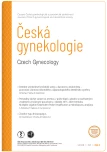Pelvic pain in women after childbirth and physiotherapy
Authors:
M. Hroncová
Authors‘ workplace:
Rehab Care, s. r. o., Košice, Slovenská republika
Published in:
Ceska Gynekol 2023; 88(3): 214-220
Category:
doi:
https://doi.org/10.48095/cccg2023214
Overview
Objective: There are many types of pelvic pain. Pelvic plexus pain, coccyx pain, pain from episiotomy scars, and vulvodynia are frequently seen in postpartum women. The aim of this study was to conduct a systematic review of studies on pelvic pain in postpartum women to assess the effect of physiotherapy interventions on each type of pain. Methods: A comprehensive literature review was conducted by searching on PubMed, Ovid Embase and Scopus Web of Science using the key words – pelvic pain, women after childbirth, pelvic girdle pain, coccygodynia, episiotomy, vulvodynia, and physiotherapy. The author reviewed all the identified articles and selected articles for inclusion according to relevance to the topic. Conclusion: Based on the analysis of the above studies, it can be concluded that a comprehensive physiotherapy designed for postpartum women that includes manual techniques, behavioral techniques, relaxation of hypo-tonic and shortened muscles and strengthening of hypotonic muscles can positively affect a wide range of pain and associated dysfunctions of the pelvic floor and trunk muscles.
Keywords:
episiotomy – Pain – postpartum women – pelvic girdle – coccyx – vulvodynia
Sources
1. Fučík T, Mašata J. Pánevní neuropatická bolest diferenciální diagnostika. Ceska Gynekol 2021; 86 (4): 279–283. doi: 10.48095/cccg2021 279.
2. Paymová L, Švabík K, Kališ V et al. Průběh porodu před císařským řezem a incidence avulze musculus levator ani při prvním následném vaginálním porodu – pilotní studie. Ceska Gynekol 2022; 87 (3): 173–178. doi: 10.48095/cccg2022173.
3. Bajerová M. Péče o jizvu po porodu cisářským řezem z pohledu fyzioterapie. Umění fyzioterapie 2018; 3 (5): 19–34.
4. Starzec-Proserpio M, Węgrzynowska M, Sys D et al. Prevalence and factors associated with postpartum pelvic girdle pain among women in Poland: a prospective, observational study. BMC Musculoskelet Disord 2022; 23 (1): 928. doi: 10.1186/s12891-022-05864-y.
5. Vleeming A, de Vries JM, Mens JM et al. Possible role of the long dorsal sacroiliac ligament in women with peripartum pelvic pain. Acta Obstet Gynecol Scand 2002; 81 (5): 430–436. doi: 10.1034/j.1600-0412.2002.810510.x.
6. Hagovská M. Fyzioterapia inkontinencie moču. 1. vyd. Košice: Univerzita Pavla Jozefa Šafárika v Košiciach 2014.
7. Hagovská M, Švihra J, Nagyová I. Effect of an exercise programme for reducing abdominal fat on overactive bladder symptoms in young overweight women. Int Urogynecol J 2020; 31 (5): 895–902. doi: 10.1007/s00192-019-041 57-8.
8. Hagovská M, Svihra J. Evaluation of duloxetine and innovative pelvic floor muscle training in women with stress urinary incontinence (DULOXING): Study protocol clinical trial (SPIRIT Compliant). Medicine (Baltimor) 2020; 99 (6): e18834. doi: 10.1097/MD.0000000000018 834.
9. Hagovská M, Svihra J, Breza J Jr et al. A randomized, intervention parallel multicentre study to evaluate duloxetine and innovative pelvic floor muscle training in women with uncomplicated stress urinary incontinence – the DULOXING study. Int Urogynecol J 2021; 32 (1): 193–201. doi: 10.1007/s00192-020-04 516-w.
10. Hagovska M, Svihra J, Horbacz A et al. The impact of different intensities of exercise on body weight reduction and overactive bladder symptoms – randomised trial. Eur J Obstet Gynecol Reprod Biol 2019; 242 : 144–149. doi: 10.1016/j.ejogrb.2019.09.027.
11. Lirette LS, Chaiban G, Tolba R et al. Coccydynia: an overview of the anatomy, etiology, and treatment of coccyx pain. Ochsner J 2014; 14 (1): 84–87.
12. Engler D, Baranowski AP, Birch Jet al. EAU Guidelines on Chronic Pelvic Pain. 2022 [online]. Dostupné z: https: //d56bochluxqnz.cloudfront.net/documents/full-guideline/EAU-Guidelines-on-Chronic-Pelvic-Pain-2022_2022-03 - 29-084111_kpbq.pdf.
13. Baril S, Czuzoj-Shulman N, Abenhaim HA. Obstetric outcomes in women with vulvodynia or vaginismus. Arch Gynecol Obstet 2022. doi: 10.1007/s00404-022-06669-z. Online adead of print.
14. Leon-Larios F, Corrales-Gutierrez I, Casado--Mejía R et al. Influence of a pelvic floor training programme to prevent perineal trauma: a quasi-randomised controlled trial. Midwifery 2017; 50 : 72–77. doi: 10.1016/j.midw.2017.03. 015.
15. Álvarez-González M, Leirós-Rodríguez R, Álvarez-Barrio L et al. Prevalence of perineal tear peripartum after two antepartum perineal massage techniques: a non-randomised controlled trial. J Clin Med 2021; 10 (21): 4934. doi: 10.3390/jcm10214934.
16. ElDeeb AM, Abd-Ghafar KS, Ayad WA et al. Effect of segmental stabilizing exercises augmented by pelvic floor muscles training on women with postpartum pelvic girdle pain: a randomized controlled trial. J Back Musculoskelet Rehabil 2019; 32 (5): 693–700. doi: 10.3233/BMR-181258.
17. Mohanty PP, Pattnaik M. Effect of stretching of piriformis and iliopsoas in coccydynia. J Bodyw Mov Ther 2017; 21 (3): 743–746. doi: 10.1016/j.jbmt.2017.03.024.
18. Morin M, Carroll MS, Bergeron S. Systematic review of the effectiveness of physical therapy modalities in women with provoked vestibulodynia. Sex Med Rev 2017; 5 (3): 295–322. doi: 10.1016/j.sxmr.2017.02. 003.
19. Sun Y, Harlow BL. The association of vulvar pain and urological urgency and frequency: findings from a community-based case-control study. Int Urogynecol J 2019; 30 (11): 1871–1878. doi: 10.1007/s00192-019-04052-2.
20. Davenport MH, Marchand AA, Mottola MF et al. Exercise for the prevention and treatment of low back, pelvic girdle and lumbopelvic pain during pregnancy: a systematic review and meta-analysis. Br J Sports Med 2019; 53 (2): 90–98. doi: 10.1136/bjsports-2018-099400.
21. Stuge B. Evidence of stabilizing exercises for low back – and pelvic girdle pain – a critical review. Braz J Phys Ther 2019; 23 (2): 181–186. doi: 10.1016/j.bjpt.2018.11.006.
22. Ferreira CW, Alburquerque-Sendi NF. Effectiveness of physical therapy for pregnancy-related low back and/or pelvic pain after delivery: a systematic review. Physiother Theory Pract 2013; 29 (6): 419–431. doi: 10.3109/09593985.2012.748114.
Labels
Paediatric gynaecology Gynaecology and obstetrics Reproduction medicineArticle was published in
Czech Gynaecology

2023 Issue 3
Most read in this issue
- Pelvic pain in women after childbirth and physiotherapy
- Physiotherapy in a patient with diastasis of the rectus abdominis muscle after childbirth
- Prevention of intrauterine adhesions
- Obesity and assisted reproduction
